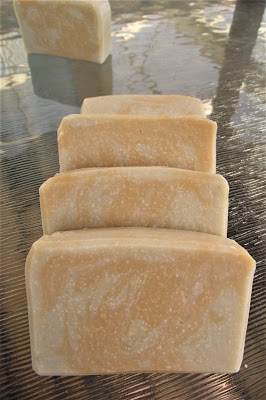I love this scent by Brambleberry, called Salty Mariner. Australians can purchase it here. It has a scent which is hard to describe, but BB does it well with the line "the thunder of waves crashing against the shore, the salty air in your face and the soft crunch of seashells beneath your feet". It does remind one of the sea, and especially salt spray. So I have named this soap "Stiff Salt Breeze" - it seems to suit it.
The wave-type swirls were achieved using Sky Blue liquid pigment dispersion and Titanium Dioxide swirled "in the pot".
I used a basic olive, coconut & palm recipe with the inclusion of rice bran oil. Probably a recipe using more fluid oils and less hard ones would suit the accelerating fragrance oil better and make the batter easier to work with. But this worked fine for me and I'm very happy with the swirls, they look very much like a swirling, salty sea.
Recipe for "Stiff Salt Breeze"
WARNING: If this is your first cold process
soap you need to learn the basics first as I won't be explaining them in this
recipe. Here are two videos on how to make cold process soap by the Soap Queen
you should watch first - Lye Safety & Ingredients and
Basic Terms. It is important that safety
procedures be strictly followed as sodium hydroxide, if not used correctly, can
cause serious injury and death.
300g olive oil
300g coconut oil
300g sustainable palm oil
100g rice bran oil
330g de-mineralised water
142g sodium hydroxide
1 tsp Titanium Dioxide powder
1/2 tsp Sky Blue liquid pigment dispersion
50g Brambleberry's Salty Mariner fragrance oil
* Weigh water and use a bit to disperse the titanium dioxide
* Mix remaining water and sodium hydroxide
and cool to approx 35-40 degrees celcius
* Meanwhile, melt oils together until about 35-40 degrees celcius
* Blend oils and lye water together until just emulsified
* Pour off half batter into another container
* Add titanium dioxide to one half and the blue liquid dispersion to the other (use the stick blender to combine well, but don't thicken too much)
* Quickly stir the fragrance oil into each half of the batter and do a quick in-the-pot swirl
* Pour batter into mould (I use this one)
* Spray with isopropyl alcohol and leave to
saponify and harden (approx 24 hours)







